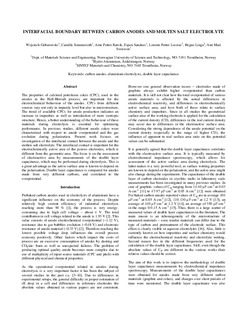| dc.contributor.author | Gebarowski, Wojciech | |
| dc.contributor.author | Sommerseth, Camilla | |
| dc.contributor.author | Ratvik, Arne Petter | |
| dc.contributor.author | Sandnes, Espen | |
| dc.contributor.author | Lossius, Lorentz Petter | |
| dc.contributor.author | Linga, Hogne | |
| dc.contributor.author | Svensson, Ann Mari | |
| dc.date.accessioned | 2017-11-06T12:43:35Z | |
| dc.date.available | 2017-11-06T12:43:35Z | |
| dc.date.created | 2016-01-21T15:17:25Z | |
| dc.date.issued | 2016 | |
| dc.identifier.citation | Light Metals. 2016, 2016 883-888. | nb_NO |
| dc.identifier.issn | 0147-0809 | |
| dc.identifier.uri | http://hdl.handle.net/11250/2464256 | |
| dc.description.abstract | The properties of calcined petroleum cokes (CPC), used in the anodes in the Hall-Héroult process, are important for the electrochemical behaviour of the anodes. CPCs from different sources vary not only in impurity level but also in microstructure. The trend of available CPCs for anode production indicates an increase in impurities as well as introduction of more isotropic structure. Hence, a better understanding of the behaviour of these materials during electrolysis is essential for optimizing performance. In previous studies, different anode cokes were characterized with respect to anode overpotential and the gas evolution during polarization. Present work focuses on investigation of the interfacial contact between the anode and the molten salt electrolyte. The interfacial contact is important for the electrochemically active area of the porous electrodes, which is different from the geometric area. The focus is on the assessment of electroactive area by measurements of the double layer capacitance, which may be performed during electrolysis. This is a great advantage as the active surface area is known to depend on the polarization. Double layer capacitance is compared for anodes made from very different carbons, and correlated to the overpotential. | nb_NO |
| dc.language.iso | eng | nb_NO |
| dc.publisher | Wiley | nb_NO |
| dc.title | Interfacial Boundary between Carbon Anodes and Molten Salt Electrolyte | nb_NO |
| dc.type | Journal article | nb_NO |
| dc.description.version | submittedVersion | nb_NO |
| dc.source.pagenumber | 883-888 | nb_NO |
| dc.source.volume | 2016 | nb_NO |
| dc.source.journal | Light Metals | nb_NO |
| dc.identifier.doi | 10.1002/9781119274780.ch149 | |
| dc.identifier.cristin | 1319705 | |
| dc.description.localcode | Copyright © 2016 The Minerals, Metals & Materials Society. This is the authors manuscript to the article. | nb_NO |
| cristin.unitcode | 194,66,35,0 | |
| cristin.unitname | Institutt for materialteknologi | |
| cristin.ispublished | true | |
| cristin.fulltext | preprint | |
| cristin.qualitycode | 1 | |
